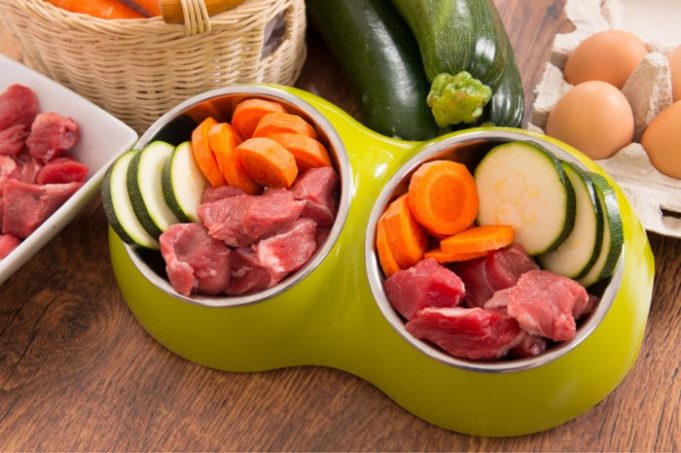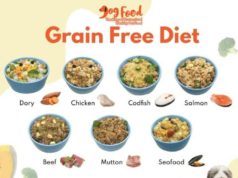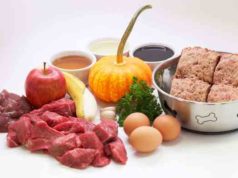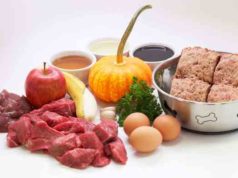What is the best diet for dogs? It’s a question that every dog owner grapples with, and the answer isn’t always straightforward. Dogs, like humans, have diverse nutritional needs, influenced by factors like breed, age, activity level, and even individual preferences. From the essentials of protein, carbohydrates, and fats to the vital role of vitamins and minerals, understanding these building blocks is crucial for providing your furry friend with a healthy and fulfilling life.
This comprehensive guide delves into the world of dog nutrition, exploring everything from commercial food options to the benefits and challenges of homemade diets. We’ll uncover the unique dietary needs of different breeds, discuss common allergies and sensitivities, and provide practical tips for establishing healthy feeding habits. Join us as we navigate the fascinating realm of dog nutrition, empowering you to make informed decisions for your canine companion’s well-being.
Understanding Dog Nutritional Needs
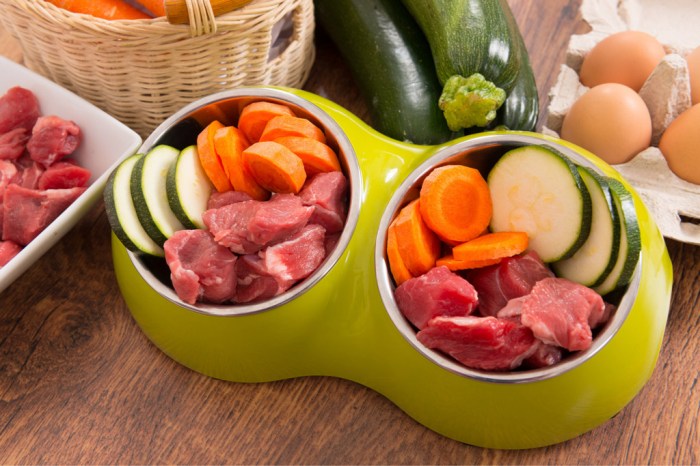
Just like humans, dogs require a balanced diet to thrive. Providing the right nutrients is crucial for their growth, development, and overall well-being. Understanding the essential nutrients and how they vary based on factors like age, breed, and activity level is key to ensuring your furry friend receives the nourishment they need.
Essential Nutrients for Dogs
A balanced diet for dogs should include the following essential nutrients:
- Protein: The building blocks for muscles, tissues, enzymes, and hormones. It is crucial for growth, repair, and immune function. Good sources include meat, poultry, fish, eggs, and dairy products.
- Carbohydrates: Provide energy for daily activities. They are also essential for brain function and nerve health. Good sources include grains like rice, oats, and barley, as well as fruits and vegetables.
- Fats: Provide concentrated energy and are essential for healthy skin and coat, hormone production, and absorption of certain vitamins. Good sources include fish oil, flaxseed oil, and healthy fats found in meat and poultry.
- Vitamins: Support various bodily functions. Vitamins A, D, E, and K are fat-soluble, while vitamins B and C are water-soluble. Good sources include fruits, vegetables, and fortified pet foods.
- Minerals: Play vital roles in bone health, muscle function, and nerve transmission. Important minerals include calcium, phosphorus, magnesium, potassium, sodium, and iron. Good sources include meat, fish, dairy products, and vegetables.
Nutritional Requirements Based on Dog Size, Age, Breed, Activity Level, and Life Stage
The specific nutritional needs of dogs vary depending on several factors:
- Size: Larger breeds typically require more calories and nutrients than smaller breeds.
- Age: Puppies need more protein and calories for growth, while senior dogs require diets that support joint health and reduced metabolism.
- Breed: Certain breeds have unique nutritional requirements based on their genetic predisposition and activity level. For example, working dogs require higher protein and calorie intake.
- Activity Level: Active dogs require more calories and nutrients to support their energy expenditure.
- Life Stage: The nutritional needs of dogs change throughout their life stages. Puppies need a diet rich in protein and calories for growth, while senior dogs require diets that support joint health and reduced metabolism.
Importance of Balanced Diets
A balanced diet is crucial for maintaining a dog’s overall health and well-being. It helps to:
- Promote healthy growth and development: Provides the essential nutrients for puppies to grow and develop properly.
- Support optimal energy levels: Provides the necessary calories and nutrients for active dogs to maintain their energy levels.
- Maintain a healthy weight: A balanced diet helps prevent obesity and its associated health problems.
- Strengthen the immune system: Provides the nutrients necessary for a strong immune system to fight off diseases.
- Improve coat health: Provides essential fatty acids and nutrients for a shiny, healthy coat.
- Support joint health: Provides nutrients like glucosamine and chondroitin that support joint health, especially important for senior dogs.
Commercial Dog Food Options
The market offers a vast array of commercial dog food options, each with its own unique composition, nutritional profile, and price point. Understanding the differences between these options is crucial for making an informed decision about what’s best for your canine companion.
Dry Kibble
Dry kibble is the most common type of dog food due to its affordability, convenience, and long shelf life. It’s made by combining ingredients like meat, grains, vegetables, and vitamins, then cooked and extruded into small, dry pieces.
- Advantages:
- Affordability: Dry kibble is generally the most budget-friendly option.
- Convenience: It has a long shelf life and doesn’t require refrigeration, making it easy to store and transport.
- Dental Health: The dry texture can help promote dental health by scraping plaque off teeth.
- Disadvantages:
- Lower Moisture Content: Dry kibble has a low moisture content, which can contribute to dehydration if not paired with sufficient water intake.
- Potential for Lower Quality Ingredients: Some dry kibble brands use lower-quality ingredients or fillers, which can impact nutritional value.
- Digestibility: Dry kibble can be less digestible than other options, especially for dogs with sensitive stomachs.
Wet Food
Wet food, often packaged in cans or pouches, offers a higher moisture content and a softer texture compared to dry kibble. It’s typically made with meat, broth, and vegetables, often featuring a higher protein content than dry kibble.
- Advantages:
- Higher Moisture Content: Wet food is a good source of hydration, particularly for dogs who struggle to drink enough water.
- Palatability: The moist texture and strong aroma often make wet food more appealing to dogs.
- Digestibility: Wet food is generally more digestible than dry kibble, making it suitable for dogs with sensitive stomachs.
- Disadvantages:
- Cost: Wet food is typically more expensive than dry kibble.
- Shelf Life: Wet food has a shorter shelf life than dry kibble and requires refrigeration after opening.
- Messy: Wet food can be messier to feed and clean up.
Semi-Moist Food
Semi-moist food offers a balance between the convenience of dry kibble and the palatability of wet food. It has a softer texture than dry kibble but a lower moisture content than wet food.
- Advantages:
- Convenience: Semi-moist food is easy to store and transport.
- Palatability: The soft texture and appealing aroma make it appealing to many dogs.
- Disadvantages:
- Lower Nutritional Value: Semi-moist food often contains higher levels of sugar and preservatives than other options.
- Digestibility: It can be less digestible than wet food and may not be suitable for dogs with sensitive stomachs.
Raw Food
Raw food diets consist of uncooked, unprocessed meat, bones, and organs. Proponents of raw food argue that it’s a more natural and biologically appropriate diet for dogs, mimicking their ancestral eating habits.
- Advantages:
- Higher Nutrient Density: Raw food contains a high concentration of nutrients, including enzymes and probiotics, which may support digestion.
- Improved Coat and Skin: Many dog owners report improved coat and skin health with raw food diets.
- Disadvantages:
- Safety Concerns: Raw food can contain harmful bacteria, parasites, and pathogens that can be dangerous to dogs and humans.
- Cost: Raw food diets are typically the most expensive option.
- Preparation Time: Raw food requires careful preparation and handling to ensure safety and proper nutritional balance.
Choosing the Best Commercial Dog Food
Selecting the best commercial dog food for your dog depends on several factors, including:
- Age: Puppies, adult dogs, and senior dogs have different nutritional needs.
- Breed: Certain breeds may have specific dietary requirements, such as large breeds or those prone to joint problems.
- Activity Level: Active dogs need more calories and protein than less active dogs.
- Health Conditions: Dogs with allergies, digestive issues, or other health conditions may require specialized diets.
- Budget: Consider your budget and choose a food that fits within your financial constraints.
It’s essential to consult with your veterinarian to determine the best food for your dog’s individual needs. They can help you select a food that provides the right balance of nutrients, promotes optimal health, and meets your budget.
Homemade Dog Food Diets
Homemade dog food diets can be a popular choice for pet owners who want to control the ingredients their dogs consume. However, it is essential to understand that creating a balanced and nutritionally complete homemade diet requires careful planning and execution.
Benefits and Risks of Homemade Diets
Homemade dog food diets offer potential benefits, including the ability to control the ingredients and avoid artificial additives, preservatives, and fillers commonly found in commercial dog food. However, it is crucial to recognize the risks associated with homemade diets, including nutritional imbalances, potential deficiencies, and the risk of foodborne illnesses.
Preparing a Homemade Dog Food Diet
Preparing a homemade dog food diet requires careful consideration of your dog’s nutritional needs.
- Consult with your veterinarian to determine the appropriate calorie intake and nutrient requirements for your dog based on its age, breed, activity level, and health condition.
- Choose high-quality, fresh ingredients, including lean meats, vegetables, fruits, and grains. Ensure the ingredients are free from harmful toxins or contaminants.
- Use a reliable recipe or consult with a veterinary nutritionist to ensure the diet is balanced and provides all essential nutrients.
- Cook the food thoroughly to eliminate potential pathogens and ensure proper digestion.
- Store the food properly to prevent spoilage and maintain freshness.
Important Considerations for Homemade Diets
- It is crucial to ensure that the homemade diet provides all the essential nutrients, including protein, carbohydrates, fats, vitamins, and minerals, in the appropriate proportions.
- Regularly monitor your dog’s weight, energy levels, and overall health to ensure the diet is meeting its needs.
- Consider supplementing the homemade diet with commercially available supplements to address potential nutrient deficiencies.
Recipes and Nutritional Guidelines
Numerous recipes for homemade dog food are available online and in books. However, it is essential to consult with your veterinarian or a veterinary nutritionist to ensure the recipe is appropriate for your dog’s specific needs.
A typical homemade dog food recipe might include:
- Lean ground meat (beef, chicken, turkey, or lamb)
- Cooked brown rice or quinoa
- Chopped vegetables (carrots, peas, green beans, broccoli)
- Fruits (apples, bananas, berries)
- Eggs
- Olive oil or flaxseed oil
Here are some nutritional guidelines to consider:
- Protein: 25-30% of total calories
- Fat: 15-20% of total calories
- Carbohydrates: 40-50% of total calories
- Vitamins and Minerals: Supplement as needed to ensure adequate intake.
Dietary Considerations for Specific Dog Breeds: What Is The Best Diet For Dogs
Every dog breed has unique nutritional needs based on its size, activity level, and genetic predispositions. Understanding these needs is crucial for providing your canine companion with a healthy and balanced diet.
Large Breed Dogs
Large breed dogs, such as Great Danes, Mastiffs, and Saint Bernards, have specific dietary requirements due to their rapid growth and potential for joint problems. Their diet should be formulated to support healthy growth and development while minimizing the risk of orthopedic issues.
- Controlled Growth: Large breed dogs should be fed a diet with a lower calorie density and higher protein content to promote controlled growth and reduce the risk of bone and joint problems.
- Joint Support: Glucosamine and chondroitin, which are naturally occurring compounds that support joint health, should be included in their diet.
- Calcium and Phosphorus Balance: Maintaining a proper balance of calcium and phosphorus is crucial for bone health in large breed dogs.
Small Breed Dogs
Small breed dogs, such as Chihuahuas, Yorkshire Terriers, and Miniature Schnauzers, have unique dietary needs due to their smaller size and higher metabolic rate.
- Higher Calorie Density: Small breed dogs require a diet with a higher calorie density to meet their energy needs due to their faster metabolism.
- Dental Health: Small breed dogs are prone to dental problems, so their diet should include kibble that helps to clean their teeth.
- Hypoglycemia: Small breed dogs can be susceptible to hypoglycemia, so it’s important to feed them small, frequent meals.
Working Dogs
Working dogs, such as Border Collies, German Shepherds, and Labrador Retrievers, require a diet that provides the energy and nutrients needed to support their high activity levels.
- Increased Protein and Fat: Working dogs require a higher intake of protein and fat to provide the energy needed for their demanding work.
- Electrolyte Balance: Working dogs lose electrolytes through sweat, so it’s important to ensure their diet includes adequate electrolytes.
- Hydration: Working dogs need to be adequately hydrated, especially during strenuous activity.
Dogs with Specific Health Conditions
Dogs with specific health conditions, such as diabetes, kidney disease, or allergies, require specialized diets tailored to their needs.
- Diabetes: Diabetic dogs need a diet low in carbohydrates and high in protein and fiber to help regulate blood sugar levels.
- Kidney Disease: Dogs with kidney disease require a diet low in protein and phosphorus.
- Allergies: Dogs with food allergies need to be fed a diet that excludes the ingredients that trigger their allergies.
Common Dog Food Allergies and Sensitivities
Just like humans, dogs can experience allergic reactions to certain ingredients in their food. These reactions can manifest in various ways, ranging from mild skin irritation to more severe symptoms like gastrointestinal upset. Understanding the common culprits and how to manage these sensitivities is crucial for ensuring your dog’s well-being.
Food Allergies and Sensitivities in Dogs
Food allergies and sensitivities are distinct but related conditions. A food allergy is an immune-mediated response to a specific protein in food. When a dog with a food allergy ingests the allergen, their immune system overreacts, releasing histamine and other chemicals that trigger symptoms. On the other hand, food sensitivities are not immune-mediated but rather involve an adverse reaction to a food component that doesn’t involve the immune system.
Common Food Allergens in Dogs
While any ingredient can potentially trigger a reaction, some are more commonly implicated in dog allergies and sensitivities. These include:
- Beef: A popular protein source in dog food, beef is a common allergen for dogs. Symptoms can include itching, gastrointestinal upset, and ear infections.
- Chicken: Another prevalent protein source in dog food, chicken is also a frequent allergen for dogs. Symptoms are similar to those seen with beef allergies.
- Dairy: Milk and other dairy products are often added to dog food for flavor and nutritional value. However, they can trigger allergies in some dogs, leading to vomiting, diarrhea, and skin problems.
- Wheat: A common grain in dog food, wheat can cause allergic reactions in dogs, resulting in itching, digestive issues, and ear infections.
- Soy: Soy is sometimes used as a protein source or filler in dog food. It can be an allergen for dogs, causing symptoms like itching, gastrointestinal upset, and skin problems.
- Eggs: Eggs are a good source of protein and often included in dog food. However, they can trigger allergies in some dogs, leading to similar symptoms as other common allergens.
Identifying and Managing Food Allergies and Sensitivities
Diagnosing food allergies and sensitivities in dogs can be challenging, as symptoms can mimic other conditions. If you suspect your dog might have a food allergy or sensitivity, it’s crucial to consult with your veterinarian. They can help rule out other causes and recommend the best course of action.
Diet Elimination Trials
A common method for identifying food allergies is a diet elimination trial. This involves feeding your dog a highly hydrolyzed protein diet, which contains proteins that have been broken down into smaller, less allergenic molecules. This diet eliminates the most common allergens and allows your dog’s body to recover. If your dog’s symptoms improve on this diet, your veterinarian may then introduce one ingredient at a time to determine the specific allergen.
It’s essential to work closely with your veterinarian during a diet elimination trial. They can monitor your dog’s progress and provide guidance on managing the trial effectively.
Feeding Practices and Portion Control
Establishing a regular feeding schedule and providing appropriate portion sizes are crucial for maintaining your dog’s health and well-being. Consistent feeding practices help regulate your dog’s metabolism, prevent overeating, and minimize the risk of digestive issues.
Feeding Schedules and Portion Control
A consistent feeding schedule helps regulate your dog’s metabolism and digestive system. It also prevents overeating and helps maintain a healthy weight.
Free-Feeding vs. Scheduled Feeding
Free-feeding involves leaving food available for your dog to eat whenever they want. This approach can be suitable for some dogs, particularly those with low activity levels or those who are prone to overeating. However, free-feeding can lead to overeating and weight gain, especially for dogs who are more active or prone to overeating.
Scheduled feeding involves providing meals at specific times throughout the day. This approach is generally recommended for most dogs, as it helps regulate their eating habits and prevents overeating. The number of meals per day will vary depending on your dog’s age, activity level, and breed.
Determining Appropriate Portion Sizes
The amount of food your dog needs will depend on several factors, including their age, breed, activity level, and metabolism.
General Guidelines:
– Puppies: Require more frequent meals than adult dogs, as their growth and development needs are high.
– Adult Dogs: Typically require one or two meals per day.
– Senior Dogs: May need to eat more frequently, especially if they have digestive issues.
– Active Dogs: Require more calories than less active dogs.
– Dogs with Medical Conditions: May require a specific diet or feeding schedule.
Tips for Preventing Overfeeding
Overfeeding can lead to weight gain, which can contribute to various health problems, including joint issues, diabetes, and heart disease.
- Follow the feeding guidelines on your dog’s food bag. These guidelines are based on your dog’s weight and activity level.
- Measure your dog’s food using a measuring cup or scale. Avoid estimating portion sizes.
- Divide your dog’s daily food allowance into two or three meals. This helps prevent overeating at a single meal.
- Avoid giving your dog table scraps or treats in excess. These can contribute to weight gain.
- Monitor your dog’s weight regularly. If you notice any significant weight gain, consult with your veterinarian.
Maintaining a Healthy Weight
Maintaining a healthy weight is essential for your dog’s overall health and well-being.
- Regular exercise is crucial for maintaining a healthy weight. Aim for at least 30 minutes of exercise per day.
- Choose a dog food that is formulated for your dog’s age, breed, and activity level.
- Limit treats and table scraps.
- Monitor your dog’s weight regularly and consult with your veterinarian if you notice any significant weight changes.
Treats and Supplements
Treats can be a fun and rewarding part of your dog’s life, but it’s crucial to choose healthy options that complement their balanced diet. Dietary supplements, when used appropriately, can also address specific nutritional needs, but it’s essential to understand their potential benefits and risks.
Healthy Treat Options
Selecting healthy treats for your dog is essential to avoid contributing to weight gain or nutritional imbalances. Here are some guidelines:
- Choose treats that are low in calories, fat, and sodium.
- Look for treats made with whole, natural ingredients, such as meat, fruits, vegetables, and grains.
- Avoid treats that contain artificial colors, flavors, and preservatives.
- Consider homemade treats made with fresh ingredients, allowing you to control the ingredients and nutritional content.
Dietary Supplements for Dogs
Dietary supplements can be beneficial for addressing specific nutritional needs, but they should always be used under the guidance of a veterinarian.
- Vitamins and Minerals: These supplements can help address deficiencies, particularly in dogs with specific dietary needs or health conditions. For example, dogs with joint problems may benefit from glucosamine and chondroitin supplements.
- Probiotics: These supplements contain beneficial bacteria that can improve gut health and digestion. They can be helpful for dogs with digestive issues or those who have been on antibiotics.
It’s crucial to remember that supplements should not replace a balanced diet. They are intended to address specific nutritional needs, not to compensate for a poor diet.
Incorporating Treats and Supplements into a Balanced Diet
Treats and supplements should be given in moderation and integrated into your dog’s overall dietary plan.
- Treats: Treats should make up no more than 10% of your dog’s daily caloric intake. Consider using treats as training rewards or for positive reinforcement.
- Supplements: Always consult your veterinarian before giving your dog any supplements. They can advise on the appropriate type, dosage, and duration of supplementation based on your dog’s individual needs.
Water and Hydration
Water is essential for life, and dogs are no exception. Just like humans, dogs need to drink plenty of fresh, clean water to stay healthy and hydrated. Water helps regulate body temperature, transport nutrients, and flush out waste products.
Factors Affecting Water Intake, What is the best diet for dogs
A dog’s water intake can vary depending on several factors, including their activity level, the weather conditions, and their overall health status. Dogs that are more active or live in hot climates will need to drink more water than dogs that are less active or live in cooler climates. Dogs with certain medical conditions, such as kidney disease or diabetes, may also need to drink more water.
Tips for Encouraging Water Consumption
Here are some tips for encouraging your dog to drink more water:
- Provide multiple water bowls in different locations throughout your home.
- Make sure the water bowls are always clean and filled with fresh water.
- Consider adding ice cubes to the water bowl to make it more appealing.
- Offer your dog water after exercise or playtime.
- If your dog is prone to dehydration, consider adding a water-soluble supplement to their water bowl.
Dietary Changes and Transitions
Switching your dog’s diet abruptly can lead to digestive upset and potentially hinder their health. It’s crucial to transition them gradually to a new food to allow their system to adapt and minimize any adverse reactions.
Gradual Transition
A gradual transition allows your dog’s digestive system to adjust to the new food’s ingredients, digestibility, and nutrient profile. This process minimizes the risk of digestive issues like diarrhea, vomiting, or gas.
- Start by mixing a small amount of the new food with their current food, gradually increasing the proportion of the new food over several days.
- For example, start with a 25% ratio of new food to old food for the first day, increasing to 50% on the second day, 75% on the third day, and 100% on the fourth day.
- Monitor your dog’s stool consistency and overall well-being during this period.
Transition Period Challenges
While transitioning, you may encounter some challenges:
- Refusal to Eat: Some dogs might be hesitant to try new food. You can try adding a small amount of wet food or broth to make the new food more appealing.
- Digestive Upset: If your dog experiences diarrhea or vomiting, slow down the transition process. You can even revert to the previous diet for a day or two before continuing with the transition.
- Changes in Stool Consistency: It’s normal for stool consistency to change during the transition. If it becomes excessively loose or watery, reduce the amount of new food and consult your veterinarian.
Maintaining a Healthy Diet Throughout a Dog’s Life
Just like humans, dogs require a balanced diet to thrive throughout their lives. As your furry friend ages, their nutritional needs change, and it’s crucial to adapt their diet accordingly. Regular veterinary checkups are essential to monitor your dog’s health and ensure they’re getting the right nutrients.
Dietary Changes Throughout a Dog’s Life
A dog’s dietary needs vary significantly from puppyhood to senior years. Puppies require high-calorie diets rich in protein and essential nutrients to support their rapid growth. As dogs mature, their calorie requirements decrease, and their need for joint support and digestive health may increase. Senior dogs often experience age-related changes, such as decreased metabolism and increased risk of health issues.
Puppyhood
During this stage, puppies need a diet that provides ample protein for muscle growth, calcium for bone development, and essential fatty acids for brain development. High-quality puppy food formulated for their specific breed and age is recommended.
Adulthood
Once your dog reaches adulthood, their dietary needs shift to maintenance. Adult dog food should contain a balanced ratio of protein, carbohydrates, and fats to support their energy levels and overall health.
Senior Years
As dogs age, their metabolism slows down, and their nutritional needs change. Senior dog food is specially formulated to address these changes, often containing lower calorie content, higher levels of antioxidants, and joint support ingredients.
Tips for Maintaining a Healthy Diet
Maintaining a healthy diet throughout a dog’s life is crucial for promoting longevity and preventing health issues.
Regular Veterinary Checkups
Regular checkups allow your veterinarian to monitor your dog’s health and assess their nutritional needs. They can recommend the appropriate diet based on your dog’s age, breed, activity level, and any health conditions.
Monitoring Changes in Health
Be attentive to any changes in your dog’s behavior, appetite, or weight. These could be signs of underlying health issues that may require dietary adjustments.
Feeding a Balanced Diet
Ensure your dog receives a complete and balanced diet that meets their nutritional requirements. High-quality commercial dog food or a homemade diet formulated by a veterinarian can provide the necessary nutrients.
Portion Control
Overfeeding can lead to obesity, which can increase the risk of various health problems. Follow the feeding guidelines on the dog food packaging or consult your veterinarian for personalized recommendations.
Avoiding Table Scraps
While it’s tempting to share your food with your dog, many human foods are toxic or unhealthy for them. Stick to their designated diet and avoid giving them table scraps.
Providing Fresh Water
Always ensure your dog has access to fresh, clean water. Dehydration can lead to health problems, especially in older dogs.
Regular Exercise
Regular exercise helps maintain a healthy weight and promotes overall well-being. Encourage your dog to engage in activities that suit their age and physical condition.
Outcome Summary
Ultimately, the best diet for your dog is one that meets their individual needs and preferences. By understanding the principles of dog nutrition, you can confidently choose the right food for your furry friend. Remember, regular veterinary checkups are essential for monitoring your dog’s health and making adjustments to their diet as needed. With a little knowledge and attention, you can provide your dog with the nourishment they need to thrive and live a long, happy life.
Question Bank
What are some signs that my dog might be allergic to their food?
Common signs of food allergies in dogs include itching, skin rashes, digestive issues (like vomiting or diarrhea), and ear infections. If you suspect your dog has a food allergy, consult your veterinarian for proper diagnosis and treatment.
How often should I feed my dog?
The frequency of feeding depends on your dog’s age, size, and activity level. Puppies typically need to eat more frequently than adult dogs. Consult your veterinarian for specific feeding recommendations based on your dog’s individual needs.
Can I give my dog human food?
While some human foods are safe for dogs in moderation, many can be harmful or even toxic. It’s best to stick to dog-specific foods and treats to ensure your dog receives the proper nutrition and avoid any potential health risks.
What are some good treats for dogs?
Choose treats that are low in calories, sugar, and artificial ingredients. Good options include small pieces of cooked chicken or fish, plain yogurt, and commercially available dog treats made with natural ingredients.
Choosing the right food for your dog is crucial for their health and well-being. Just like humans, dogs need a balanced diet tailored to their individual needs. While a high-quality commercial dog food can be a good starting point, it’s important to consider factors like age, breed, and activity level.
For example, a diabetic dog might benefit from a diet that focuses on low-glycemic carbohydrates, as outlined in a recommended diet for diabetics. Ultimately, the best diet for your dog is one that meets their specific nutritional requirements and keeps them happy and healthy.
Choosing the best diet for your dog is a big decision, as it directly impacts their health and well-being. Just like humans, dogs benefit from a balanced diet that provides all the necessary nutrients. When it comes to the “best diet 2022” for humans, there are many different approaches, and you can find a great overview of them on this website.
While these diets may not be suitable for dogs, understanding the principles of healthy eating for humans can help you make informed decisions about your dog’s diet.
Determining the best diet for your dog is a crucial step in ensuring their health and well-being. Just like you need to know how to clean dirty white shoes, how to clean dirty white shoes , a balanced diet is essential for a dog’s optimal health and energy levels.
Consult with your veterinarian to create a personalized dietary plan tailored to your dog’s specific needs and breed.















